The Bottom Board of a Harpsichord
From an overall energy standpoint, the soundboard of a northern model harpsichord acts primarily as a non-resonant piston. This note explores the effect of the air enclosed by a harpsichord on the soundboard response.
Using an impulse method, I measured the response of my harpsichord at five points on the 8' bridge: C, c, c', c'' and c'''. For each, 3 impulses were recorded and a quiet section to measure noise background. Fourier transforms of each were taken, the noise spectrum subtracted from each of the impulse spectra, then the 3 resulting spectra normalized then averaged. The results are shown at right. Harpsichord sound production may be non-resonant to first order, but it obviously isn't when examined in more detail.
Savage et.al. showed that the internal air resonances of a harpsichord could be usefully modelled by a sector of a cylinder, for which an exact solution of the wave equation is possible. The solution forms three series, lengthwise (1), radial (2-dimensional) (2), and vertical (3).
The air cavity of my Ross is about 182 cm long inside and 18 cm high. The bentside is a straight line over much of its length, of sector angle 0.3 radians. However, approximating the tail plus bentside by a straight line gives an angle of 0.45 radians. The value of n in (2) may therefore be anywhere in the range 7 to 10 for m=1.
Following Savage, the acoustic length L was determined using the lengthwise resonances. The first minimum of J0 is at x=3.83. Lining the values up to 1 kHz against the resonance spectrum at c (which should excite the lengthwise modes most cleanly), the best fit is at L=201 cm. This is similar to Savage, who obtained an acoustic length of 170 cm with an instrument of air cavity length 152 cm. The extra acoustic length is presumably produced by the difference between the actual shape of the cavity and a sector, and by the gap between the upper and lower belly rails acting as an acoustic port. (Savage poured sand on his soundboard to damp wood resonances, and drilled holes in its case for sound probes and loudspeakers to determine which resonance was which. I didn't!)
The acoustic sector angle was determined using the spectra at c'', which is off center and should excite radial modes the best. The best fit for L=201 is with n=9.5, corresponding to a sector angle of 0.33 radians. The 2nd and 3rd order radial resonances were then calculated given L=201 and n=9.5
Every resonance predicted by Savage's theory below 500 Hz clearly matches up with an observed resonance in my instrument. (At higher frequencies, the density of resonances is so high that the significance of matches is uncertain.)
The next step was to quantify the air resonances. For each resonance, the data surrounding it was examined to determine how many other resonances there are close to the air resonance. In the example at right, the initial fit was to the data marked by the red bar assuming four resonances. The fitting procedure determined the smallest peak to not be significant, so the final fit was to the three major resonances. The result of this fit was a frequency of 452.2 Hz, amplitude 0.261 and halfwidth 3.9 Hz for the 5th resonance in the lengthwise series for the bridge at c'', as shown in green.
The reliability of the procedure was checked by comparing the frequencies obtained independently from each of the five spectra. For example, the first lengthwise resonance frequency was C=108.1, c=108.2, c'=108.5, c''=109.0, c'''=107.6. The mean is 108.3, sigma 0.5 Hz. The initial location for the 2nd longitudinal frequency was then determined from the Bessel function values, 108.3x7.03/3.83, 198.3 Hz, to maximize the likelihood that the correct resonances were chosen in each case.
Savage's observations with free soundboard fit his Bessel predictions with a consistency sigma of about 5 Hz. Mine are consistent to about 2 Hz, and I doubt that my work is in fact more accurate than his. Savage found 1 resonance per 16.8 Hz for his instrument, about what I am finding as shown by the typical sample at right, 70 Hz wide with what appears to be 3 single and two split resonances. I suspect that resonances are so close together that I am misidentifying some. Nevertheless, the result gives the important answer, evident from the graph at right where air resonances (blue) are separated from wood resonances (green) for c' up to 500 Hz, where I am sure of the identifications: wood resonances seem more important than air resonances to the character of my harpsichord sound.
When there is no bottom board, sound from the under side of the soundboard combines with the sound from the top. The effect of this depends on the listener's distance and direction, and whether or not the lid is at 45° to reflect the top sound out. Without a lid, the response of a harpsichord with 27 cm sides will be that of the black curve below 180 Hz - with one, it will be intermediate between the black and green curves.
This result will not be verified by experiment on my instrument! However, I have added bottom boards to a number of modern open-bottomed spinets, and can vouch that the effect on the sound was small. The principal effect was to increase the prominence of the ictus.
The primary value of the bottom board of a northern harpsichord is as a structural element. The air space it encloses produces a few air resonances, which are outweighed in importance by wood resonances. Directly, it is less vital to harpsichord sound than most harpsichord vs. piano literature claims.
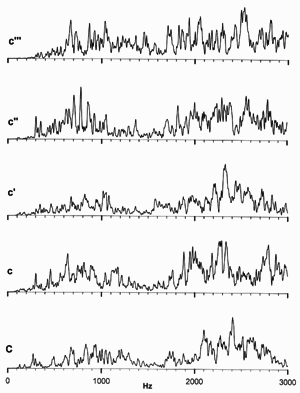
soundboard response

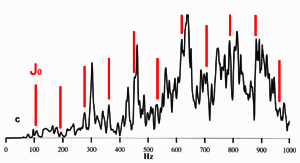
identifying longitudinal air resonances
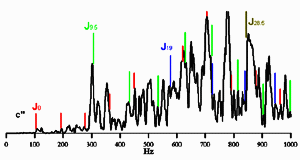
identifying radial air resonances
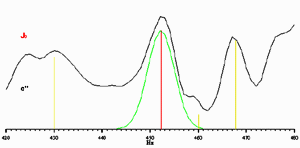
fitting of a resonance
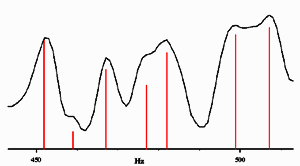
density of resonances
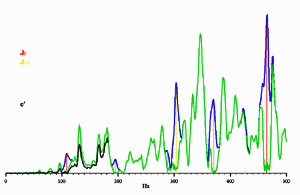
air and wood resonances separated